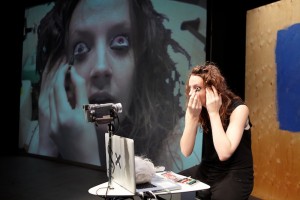
A woman in only nude colored underwear applies powder all over her face.
She then brushes heavy white makeup on to her eyelids. She leaves her eyes closed and positions dark circles in the middle of her lids.
A new pair of eyes look into the camera as she takes the white brush to her lips and creates a new set of teeth.
Lastly she takes L’Oréal Rouge and smears it all around her mouth and chin.
A blonde wig is placed atop of her head and the transformation is complete.
This is may sound like a weird video you stumbled across on your late night internet travels but this was a live performance, one which couldn’t be muted or skimmed over.
Last Saturday Winnipeg artist Freya Olafson performed her piece Avatar at the Charlotte Street Arts Centre. The show’s theme is “I post therefore I am.”
“The more I played around with my webcam, the more I thought of all the free software you can get to take ridiculous pictures of yourself both through video and photo to kind of archive your existence in your personal machine,” said Olafson.
“Individually we mediate our personal lives and what we publically put online. We choose and select avatars in attempts to create our virtual identity online. It can be the picture you choose on Facebook, or online blogs or whatever you identify with.”
The stage was bare except for a pull down screen, a stool and a laptop. It would become a performance with a live video feed and develop as a duet between Olafson and her laptop.
“I didn’t want any behind the scenes special effects or hidden gadgets. The computer is right there and it’s a part of the show. It’s a critical relationship with the camera. This show doesn’t have that ‘oh my god how is she doing that?’ suspense,” said Olafson.
An image of earth lights up the screen. Pictures of outer space blur into pictures of the performer. Self shots, group photos and cute couple photos were rapidly clicked upon.
Then the world of social media’s “tagged” photos was replaced by YouTube.
Videos of bodybuilders jumped across the stage as virtual strippers who worked poles were layered on top of the videos. A digital copy of Olafson danced among the muscles and exposed navels.
The human Olafson dances a duet with her pixelized self.
A narration breaks through the sexy defining pop-up ads. It’s a girl talking about how disgusting her body is and she will continue to post videos to document her weight loss.
“They are using the computer and its camera as a mirror to critique one’s self,” said Olafson.
The text in the show is taken from people’s online diaries. They are all different ages and genders.
“In the end of this piece it happens that I directly alter parts of myself in terms of physical appearance, how I sound and mannerisms. So I become a very different person than I was in the beginning. It’s sort of a transformation of becoming more and more absolved into the computer,” said Olafson.
This was the buildup to the makeup tutorial. Olafson pulls her laptop and chair over to a blank canvas which she starts viciously painting blue. Her voice is dubbed by a young girl’s, who reads what you will need in order to complete your new look.
The canvas in the background was a reminder that all these mindless videos we watch every day is similar to watching paint dry.
“The way I follow her instructions makes me grow into this grotesque character and for the second half of the piece I perform with my eyes closed,” said Olafson. “When you follow things online, there’s great opportunity for misinformation as well.”
The remainder of the show turns into an online video blog. The transformed character takes on the voice of a man and begins apologizing for not posting for a few days. For the next ten minutes the character spiels on about how they were sick, the purchase of a new camera and the painting of a bedroom.
It was similar to the millions of blogs which pop up on the internet every day. Pointless rants about boring lives.
People are constantly exposing their emotionally charged diaries or weight loss goals.
Avatar shows that it doesn’t matter if anyone’s actually watching or how many subscribers your videos have. Olafson’s show exploits the idea that we’re all just trying to build our own online identity.
“There are a lot of possibilities for people to connect beyond their community, whether they feel ostracized for their sexuality or politics or what have you. The internet can be a pretty powerful tool for knowledge exchange of the good or the bad,” said Olafson.
“It’s all malleable. We just choose at different points in our life what we want to identify with and what we want to represent or perform to the people.”

